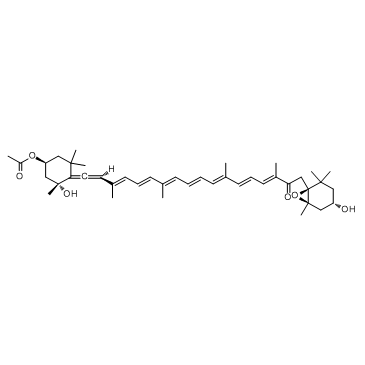Fucoxanthin

Fucoxanthin structure
|
Common Name | Fucoxanthin | ||
|---|---|---|---|---|
| CAS Number | 3351-86-8 | Molecular Weight | 676.922 | |
| Density | 1.1±0.1 g/cm3 | Boiling Point | 786.5±60.0 °C at 760 mmHg | |
| Molecular Formula | C42H58O6 | Melting Point | 166-168ºC | |
| MSDS | Chinese USA | Flash Point | 228.5±26.4 °C | |
| Symbol |


GHS02, GHS07 |
Signal Word | Danger | |
|
Fucoxanthin induces apoptosis in human cervical cancer cell line HeLa via PI3K/Akt pathway.
Tumour Biol. 35(11) , 11261-7, (2014) Cervical cancer (CC) is a malignant neoplasm arising from cells originating in the cervix uteri, among the top causes of death from cancer in women. In a gene expression profiling study of metabolic response to treatment, PI3K/Akt signaling pathway are associ... |
|
|
Biological Properties of Fucoxanthin in Oil Recovered from Two Brown Seaweeds Using Supercritical CO2 Extraction.
Mar. Drugs 13 , 3422-42, (2015) The bioactive materials in brown seaweeds hold great interest for developing new drugs and healthy foods. The oil content in brown seaweeds (Saccharina japonica and Sargassum horneri) was extracted by using environmentally friendly supercritical CO2 (SC-CO2) ... |
|
|
The anti-apoptotic effect of fucoxanthin on carbon tetrachloride-induced hepatotoxicity.
J. Toxicol. Sci. 38(1) , 115-26, (2013) This study evaluated the anti-apoptotic activity of fucoxanthin in carbon tetrachloride (CCl(4))-induced hepatotoxicity. An in vitro study using the 3-(4,5-dimethylthiazol-2-yl) 2,5-diphenyltetrazolium bromide (MTT) assay clearly demonstrated an attenuation o... |
|
|
Comparative effects between fucoxanthinol and its precursor fucoxanthin on viability and apoptosis of breast cancer cell lines MCF-7 and MDA-MB-231.
Anticancer Res. 35(1) , 207-19, (2015) We evaluated whether low doses of the natural carotenoid fucoxanthin and/or of its metabolite fucoxanthinol are effective against proliferation of estrogen-sensitive MCF-7 and estrogen-resistant MDA-MB-231 breast cancer cell lines.These cell lines were stimul... |
|
|
Simultaneous Determination of Fucoxanthin and Its Deacetylated Metabolite Fucoxanthinol in Rat Plasma by Liquid Chromatography-Tandem Mass Spectrometry.
Mar. Drugs 13 , 6521-36, (2015) Fucoxanthin and its deacetylated metabolite fucoxanthinol are two major carotenoids that have been confirmed to possess various pharmacological properties. In the present study, fucoxanthinol was identified as the deacetylated metabolite of fucoxanthin, after... |
|
|
Fucoxanthin increases lifespan of Drosophila melanogaster and Caenorhabditis elegans.
Pharmacol. Res. 100 , 228-41, (2015) The pharmacological activation of stress-defense mechanisms is one of the perspective ways to increase human lifespan. The goal of the present study was to study the effects on lifespan of Drosophila melanogaster and Caenorhabditis elegans of two carotenoids:... |
|
|
Photo-excitation of carotenoids causes cytotoxicity via singlet oxygen production.
Biochem. Biophys. Res. Commun. 417(1) , 640-5, (2012) Carotenoids, natural pigments widely distributed in algae and plants, have a conjugated double bond system. Their excitation energies are correlated with conjugation length. We hypothesized that carotenoids whose energy states are above the singlet excited st... |
|
|
Fucoxanthinol, Metabolite of Fucoxanthin, Improves Obesity-Induced Inflammation in Adipocyte Cells.
Mar. Drugs 13 , 4799-813, (2015) Fucoxanthin (Fx) is a marine carotenoid found in edible brown seaweeds. We previously reported that dietary Fx metabolite into fucoxanthinol (FxOH), attenuates the weight gain of white adipose tissue of diabetic/obese KK-Ay mice. In this study, to evaluate an... |
|
|
Fucoxanthin content and antioxidant properties of Undaria pinnatifida.
Food Chem. 136(2) , 1055-62, (2013) This study investigated the fucoxanthin content of New Zealand (NZ) Undaria pinnatifida harvested from two locations in the Marlborough Sounds, New Zealand across its growing season. Fucoxanthin content and antioxidant properties of processed New Zealand U. p... |
|
|
Xanthigen suppresses preadipocyte differentiation and adipogenesis through down-regulation of PPARγ and C/EBPs and modulation of SIRT-1, AMPK, and FoxO pathways.
J. Agric. Food Chem. 60(4) , 1094-101, (2012) Xanthigen is a source of punicic acid and fucoxanthin derived from pomegranate seed and brown seaweed, respectively with recognized triacylglycerol-lowering effects in humans, yet the mechanism remains to be fully elucidated. The present study investigated th... |